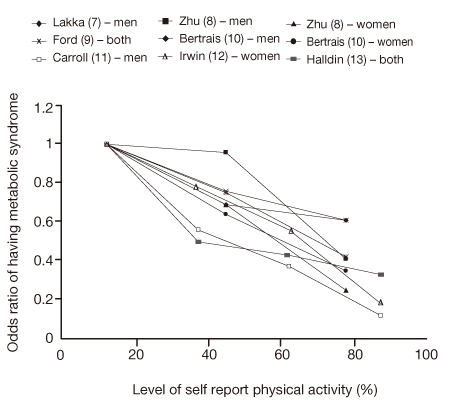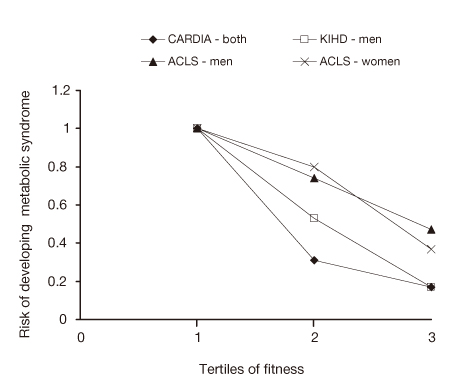 |
 |
- Search
| J Korean Med Assoc > Volume 54(7); 2011 > Article |
Abstract
The metabolic syndrome may lead to cardiovascular disease. A greater number of physical activities and better fitness decrease the prevalence and incidence of metabolic syndrome. Exercise increases insulin sensitivity and longer activities make the effect greater. Studies have shown that physical activity is also helpful in treating the metabolic syndrome. Moderate aerobic physical activity for more than 30 minutes almost every day (at least 5 or more days a week) is recommended to prevent and treat the metabolic syndrome. Moderate aerobic physical activity for more than 150 minutes total per week with intermittent resting days may be effective in managing the metabolic syndrome. Intermittent activity for periods of at least 10 minutes has been shown to be as effective as continuous activity. Examples of moderate activities are walking, brisk walking, table tennis, vacuuming, and playing drums. For a more accurate exercise prescription, a target heart rate can be used, calculated by the formula: 'target heart rate = intensity × (maximal heart rate - resting heart rate) + resting heart rate'. The intensity for moderate physical activities is 40% to 50%. Maximal heart rate is assumed to be '220-age'. Resistance exercise two or three times a week per muscle group is also recommended. Reducing sedentary life habits such as watching TV, playing video games, and working on a computer is recommended, too. The more physical activities in everyday life, the better the results for the metabolic syndrome. However, the exact amount of physical activity for the metabolic syndrome should be determined by further studies in Korea. Physical activity is an essential tool in the prevention and treatment of the metabolic syndrome.
References
1. Alberti KG, Zimmet P, Shaw J. IDF Epidemiology Task Force Consensus Group. The metabolic syndrome: a new worldwide definition. Lancet 2005;366:1059-1062.
2. Grundy SM, Cleeman JI, Daniels SR, Donato KA, Eckel RH, Franklin BA, Gordon DJ, Krauss RM, Savage PJ, Smith SC Jr, Spertus JA, Costa F. American Heart Association. National Heart, Lung, and Blood Institute. Diagnosis and management of the metabolic syndrome: an American Heart Association/National Heart, Lung, and Blood Institute Scientific Statement. Circulation 2005;112:2735-2752.
3. Lim S, Shin H, Song JH, Kwak SH, Kang SM, Yoon JW, Choi SH, Cho SI, Park KS, Lee HK, Jang HC, Koh KK. Increasing prevalence of metabolic syndrome in Korea: the Korean national health and nutrition examination survey for 1998-2007. Diabetes Care 2011;34:1323-1328.
4. Lim J, Kim S, Ke S, Cho B. The prevalence of obesity, abdominal obesity and metabolic syndrome among elderly in general population. Korean J Fam Med 2011;32:128-134.
5. Cho YG, Song HJ, Kang JH. Prevalence of the metabolic syndrome in Korean children and adolescents according to the International Diabetes Federation Definition in Children and Adolescents. Korean J Fam Med 2009;30:261-268.
6. Physical Activity Guidelines Advisory Committee Report, 2008 [Internet] cited 2011 May 17. Washington, DC: U.S. Department of Health and Human Services. Available from:
http://www.health.gov/PAguidelines/Report/pdf/CommitteeReport.pdf
7. Lakka TA, Laaksonen DE, Lakka HM, Mannikko N, Niskanen LK, Rauramaa R, Salonen JT. Sedentary lifestyle, poor cardiorespiratory fitness, and the metabolic syndrome. Med Sci Sports Exerc 2003;35:1279-1286.
8. Zhu S, St-Onge MP, Heshka S, Heymsfield SB. Lifestyle behaviors associated with lower risk of having the metabolic syndrome. Metabolism 2004;53:1503-1511.
9. Ford ES, Giles WH, Dietz WH. Prevalence of the metabolic syndrome among US adults: findings from the third National Health and Nutrition Examination Survey. JAMA 2002;287:356-359.
10. Bertrais S, Beyeme-Ondoua JP, Czernichow S, Galan P, Hercberg S, Oppert JM. Sedentary behaviors, physical activity, and metabolic syndrome in middle-aged French subjects. Obes Res 2005;13:936-944.
11. Carroll S, Cooke CB, Butterly RJ. Metabolic clustering, physical activity and fitness in nonsmoking, middle-aged men. Med Sci Sports Exerc 2000;32:2079-2086.
12. Irwin ML, Ainsworth BE, Mayer-Davis EJ, Addy CL, Pate RR, Durstine JL. Physical activity and the metabolic syndrome in a tri-ethnic sample of women. Obes Res 2002;10:1030-1037.
13. Halldin M, Rosell M, de Faire U, Hellénius ML. The metabolic syndrome: prevalence and association to leisure-time and work-related physical activity in 60-year-old men and women. Nutr Metab Cardiovasc Dis 2007;17:349-357.
14. Laaksonen DE, Lakka HM, Salonen JT, Niskanen LK, Rauramaa R, Lakka TA. Low levels of leisure-time physical activity and cardiorespiratory fitness predict development of the metabolic syndrome. Diabetes Care 2002;25:1612-1618.
15. Franks PW, Ekelund U, Brage S, Wong MY, Wareham NJ. Does the association of habitual physical activity with the metabolic syndrome differ by level of cardiorespiratory fitness? Diabetes Care 2004;27:1187-1193.
16. Ekelund U, Brage S, Franks PW, Hennings S, Emms S, Wareham NJ. Physical activity energy expenditure predicts progression toward the metabolic syndrome independently of aerobic fitness in middle-aged healthy Caucasians: the Medical Research Council Ely Study. Diabetes Care 2005;28:1195-1200.
17. Ford ES, Kohl HW 3rd, Mokdad AH, Ajani UA. Sedentary behavior, physical activity, and the metabolic syndrome among U.S. adults. Obes Res 2005;13:608-614.
18. Houmard JA, Tanner CJ, Slentz CA, Duscha BD, McCartney JS, Kraus WE. Effect of the volume and intensity of exercise training on insulin sensitivity. J Appl Physiol 2004;96:101-106.
19. Ekelund U, Franks PW, Sharp S, Brage S, Wareham NJ. Increase in physical activity energy expenditure is associated with reduced metabolic risk independent of change in fatness and fitness. Diabetes Care 2007;30:2101-2106.
20. Tak YR, An JY, Kim YA, Woo HY. The effects of a Physical Activity-Behavior Modification Combined Intervention (PABM-intervention) on metabolic risk factors in overweight and obese elementary school children. J Korean Acad Nurs 2007;37:902-913.
21. Park SK, Kim EH, Kwon YC. The effects of combined training on self-reliance fitness and risk factors of metabolic syndrome in the older women. J Phys Growth Motor Dev 2006;14:37-48.
22. Kim SH. Effects of intermittent walking for health related physical fitness and metabolic syndrome risk factors in elderly women. J Korean Gerontol Soc 2009;29:1397-1411.
23. Katzmarzyk PT, Leon AS, Wilmore JH, Skinner JS, Rao DC, Rankinen T, Bouchard C. Targeting the metabolic syndrome with exercise: evidence from the HERITAGE Family Study. Med Sci Sports Exerc 2003;35:1703-1709.
24. Johnson JL, Slentz CA, Houmard JA, Samsa GP, Duscha BD, Aiken LB, McCartney JS, Tanner CJ, Kraus WE. Exercise training amount and intensity effects on metabolic syndrome (from studies of a targeted risk reduction intervention through defined exercise). Am J Cardiol 2007;100:1759-1766.
25. Jurca R, Lamonte MJ, Barlow CE, Kampert JB, Church TS, Blair SN. Association of muscular strength with incidence of metabolic syndrome in men. Med Sci Sports Exerc 2005;37:1849-1855.
26. Ainsworth BE, Haskell WL, Herrmann SD, Meckes N, Bassett DR Jr, Tudor-Locke C, Greer JL, Vezina J, Whitt-Glover MC, Leon AS. The Compendium of physical activities tracking guide [Internet] cited 2011 May 23. Phoenix (AZ): Healthy Lifestyles Research Center, Arizona State University. Available from:
https://sites.google.com/site/compendiumofphysicalactivities
Figure 1
Summary of cross-sectional physical activity and metabolic syndrome studies using categories of physical activity that could be used to examine dose-response [6].

Figure 2
Summary of longitudinal fitness and metabolic syndrome studies that used categories of fitness to examine dose-response relations. CARDIA, coronary artery risk development in young adults; KIHD, kuopio ischemic heart disease risk factor study; ACLS, aerobic center longitudinal study [6].

- TOOLS
-
METRICS

-
Related articles in
J Korean Med Assoc -
Metabolic syndrome in children and adolescents2024 May;67(5)
Obesity and Metabolic Syndrome among Children and Adolescents in Korea2010 February;53(2)
Present and future of sports medicine2011 July;54(7)
Cardiovascular diseases and sports medicine2011 July;54(7)
Orthopedic disease and sports medicine in shoulder joint2011 July;54(7)






